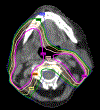Consensuses, controversies, and future directions in treatment deintensification for human papillomavirus-associated oropharyngeal cancer
- PMID: 36305841
- PMCID: PMC9992119
- DOI: 10.3322/caac.21758
Consensuses, controversies, and future directions in treatment deintensification for human papillomavirus-associated oropharyngeal cancer
Abstract
The most common cancer caused by human papillomavirus (HPV) infection in the United States is oropharyngeal cancer (OPC), and its incidence has been rising since the turn of the century. Because of substantial long-term morbidities with chemoradiation and the favorable prognosis of HPV-positive OPC, identifying the optimal deintensification strategy for this group has been a keystone of academic head-and-neck surgery, radiation oncology, and medical oncology for over the past decade. However, the first generation of randomized chemotherapy deintensification trials failed to change the standard of care, triggering concern over the feasibility of de-escalation. National database studies estimate that up to one third of patients receive nonstandard de-escalated treatments, which have subspecialty-specific nuances. A synthesis of the multidisciplinary deintensification data and current treatment standards is important for the oncology community to reinforce best practices and ensure optimal patient outcomes. In this review, the authors present a summary and comparison of prospective HPV-positive OPC de-escalation trials. Chemotherapy attenuation compromises outcomes without reducing toxicity. Limited data comparing transoral robotic surgery (TORS) with radiation raise concern over toxicity and outcomes with TORS. There are promising data to support de-escalating adjuvant therapy after TORS, but consensus on treatment indications is needed. Encouraging radiation deintensification strategies have been reported (upfront dose reduction and induction chemotherapy-based patient selection), but level I evidence is years away. Ultimately, stage and HPV status may be insufficient to guide de-escalation. The future of deintensification may lie in incorporating intratreatment response assessments to harness the powers of personalized medicine and integrate real-time surveillance.
Keywords: chemotherapy; deintensification; human papillomavirus; oral and oropharyngeal neoplasms; radiation oncology.
© 2022 The Authors. CA: A Cancer Journal for Clinicians published by Wiley Periodicals LLC on behalf of American Cancer Society.
Figures





References
-
- Damgacioglu H, Sonawane K, Chhatwal J, et al. Long-term impact of HPV vaccination and COVID-19 pandemic on oropharyngeal cancer incidence and burden among men in the USA: A modeling study. Lancet Reg Health Am. Published online December 15, 2021. doi: 10.1016/j.lana.2021.100143. - DOI - PMC - PubMed
-
- Nguyen-Tan PF, Zhang Q, Ang KK, et al. Randomized phase III trial to test accelerated versus standard fractionation in combination with concurrent cisplatin for head and neck carcinomas in the Radiation Therapy Oncology Group 0129 trial: long-term report of efficacy and toxicity. J Clin Oncol 2014; 32: 3858–66. - PMC - PubMed
Publication types
MeSH terms
Grants and funding
LinkOut - more resources
Full Text Sources
Miscellaneous

